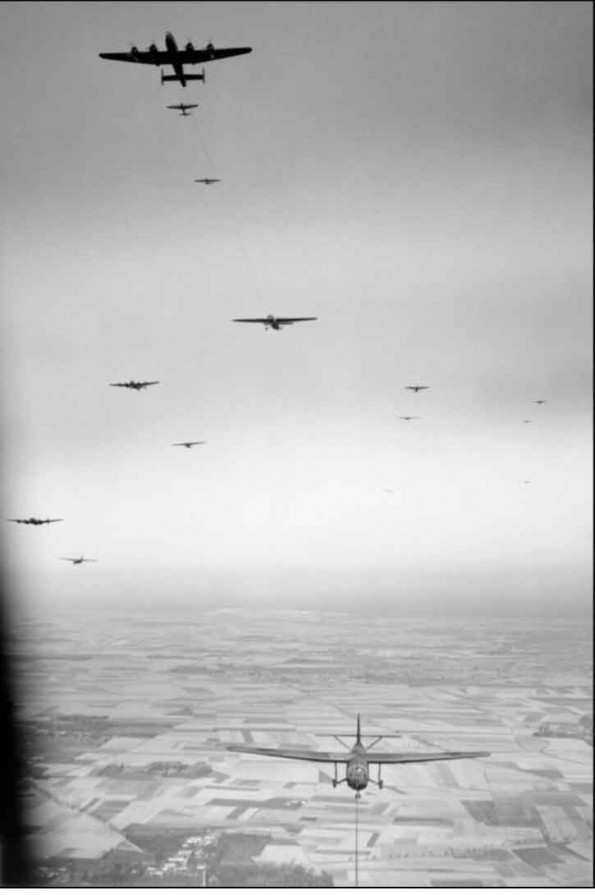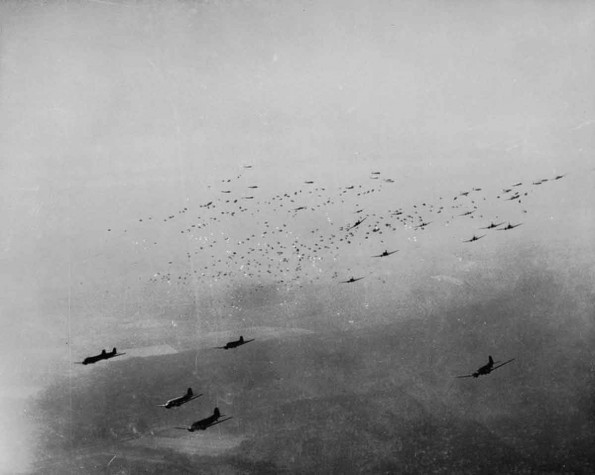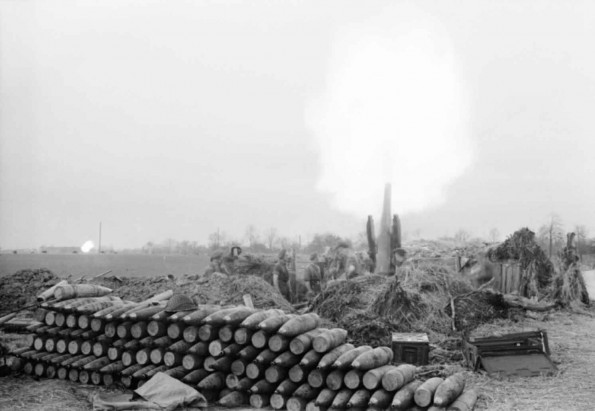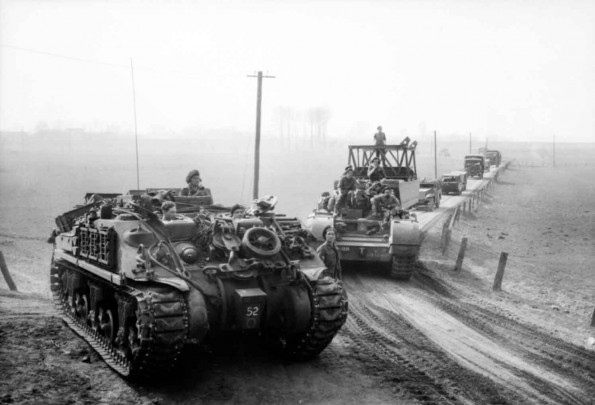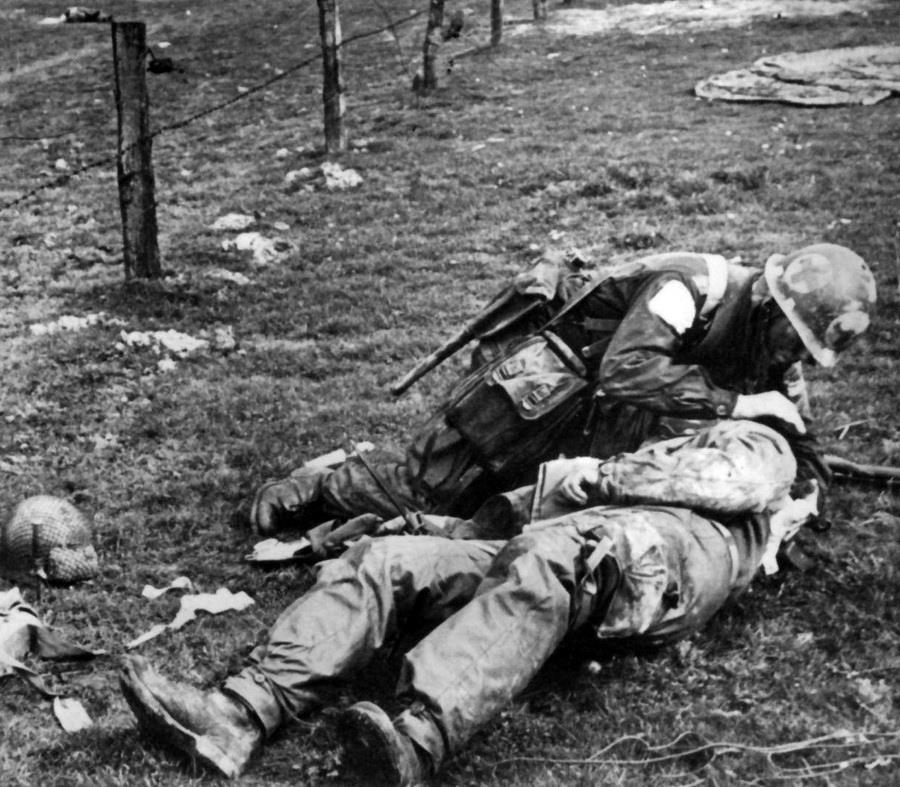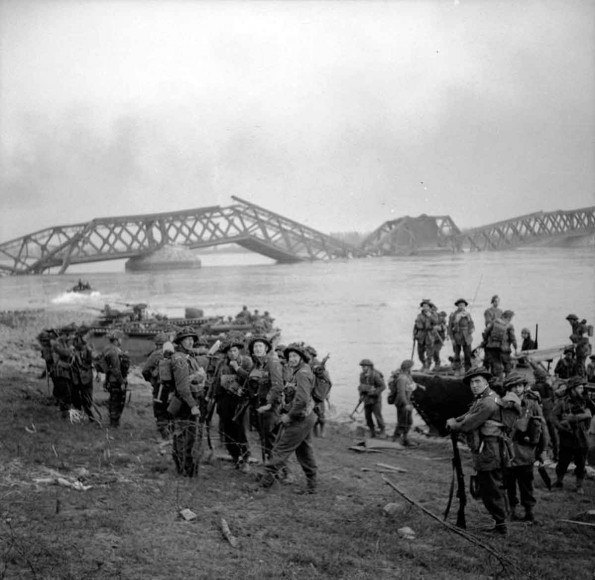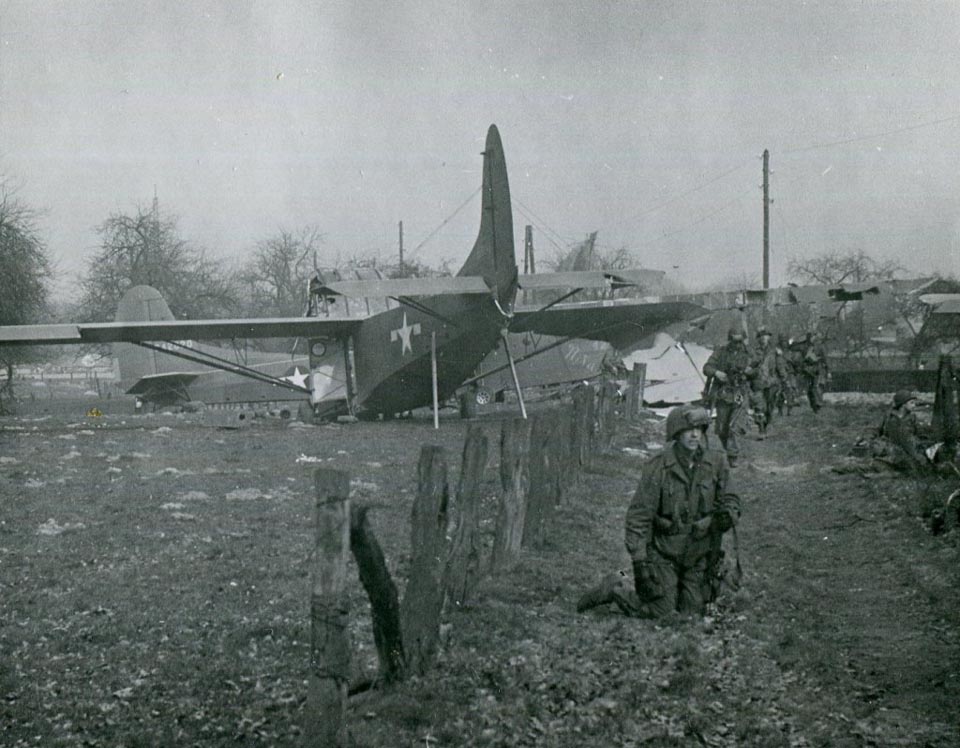Air Operations, CBI
BURMA- 9 10th Air Force B-25s and 40 fighter-bombers attack troops, motor vehicles, supplies and targets of opportunity across central Burma.
- 34 308th Heavy Bomb Group B-24s, escorted by 9 14th Air Force fighters, attack a locomotive park at Chenghsien and a bridge spanning the Yellow River.
- More that 30 341st Medium Bomb Group B-25s and more than 100 fighter bombers, organized into one-to-eight-plane flights, attack Japanese Army troops, artillery positions, locomotives, motor vehicles, bridges and other targets across southern and eastern China.
- In distant support of the upcoming Okinawa invasion, as a means to tie down Japanese aircraft in China, the 14th Air Force opens a campaign against Japanese air bases. In the first mission, 6 P-51s of the 311th Fighter Group's 530th Fighter Squadron, based at Ankang, mount a low-level sweep against air bases in the Nanking area. While attacking the airfields, the P-51s down a Ki-43 'Oscar' fighter and a Ki-44 'Tojo' fighter over the Taichiaochan airfield at 1140 hours.
Air Operations, Europe
RAF BOMBER COMMANDDaylight Ops:
- The final phase of the land war opens on this day, with the amphibious crossing of the Rhine on the Wesel sector and the airborne landings among the enemy defenses a few hours later. British Commandos capture Wesel in the early hours, just after the Bomber Command raid had left the defenders dead or too dazed to fight properly. The weather remained good for further Bomber Command operations. It is interesting to observe that the Ruhr is still supplying fuel and munitions for the fighting front which is now only 15 miles away and that tactical bombing and strategic bombing are taking place almost side by side.
- 155 Halifaxes, 16 Lancasters and 6 Mosquitos of Nos. 4 and 8 Groups attack the railway yards at Sterkrade so successfully that, according to Bomber Command, there is 'complete destruction of a well packed marshalling yard'.
- There are no losses.
- 175 aircraft including 153 Halifaxes, 16 Lancasters and 6 Mosquitos of Nos. 6 and 8 Groups attack Gladbeck situated on the northern edge of the Ruhr and not far from the new battle area. The target is 'devastated'.
- 1 Halifax is lost.
- 173 Lancasters and 12 Mosquitos of Nos. 1, 6 and 8 Groups attack the Harpenerweg plant at Dortmund and the Mathias Stinnes plant at Bottrop. 3 Lancasters are lost on the Dortmund raid.
Minor Ops:
- 67 Mosquitos are sent to Berlin, 8 to Nordheim and 2 which bombed both Berlin and Magdeburg on nuisance flights, and there are 33 Mosquito patrols and 38 RCM sorties.
- There are no losses.
GERMANY:
- Throughout the day--in support of Operation VARSITY, the Anglo-American airborne assault across the Rhine River--1st Air Division B-17s mount 706 effective bombing sorties against numerous Luftwaffe airfields and bases throughout northern and northwestern Germany.
- VIII Fighter Command fighters mount 1,297 effective sorties throughout the day.
- 5 B-17s and 9 fighters are lost.
GERMANY:
- 9th Air Division bombers mount 688 effective sorties against flak concentrations, rail bridges, communications centers, and many tactical targets in and around the Operation VARSITY battle area.
- Throughout the day, 9th Air Force fighters mount 2,039 effective sorties in direct support of Allied ground forces and mount attacks to block access to the battle area by German reinforcements.
- 8th, 9th, and 1st Tactical Air Force fighter pilots down a Ju-87 and 64 Luftwaffe fighters over Germany between 0244 and 1855 hours.
GERMANY:
- Beginning at 1000 hours--following intensive clearing attacks by USAAF fighters, including attacks on flak concentrations and airfields--paratroopers and glider-borne forces of the British 6th and US 17th Airborne Divisions taking part in Operation VARSITY are droppedn into landing zones around Wesel by 2,029 IX Troop Carrier Command C-47s and gliders and 839 RAF aircraft and gliders. The landings are supported by low-level supply drops conducted by 240 2nd Air Division B-24s and by an attack on nearby Nordhorn Airdrome by 58 466th Heavy Bomb Group B-24s.
- 14 B-24s are lost, mostly to small arms fire, while dropping supplies; 39 C-47s are downed by flak, 1 C-47 is lost in an accident, 6 C-47s are lost to unknown causes.
AUSTRIA:
- 12th Air Force B-25s attack bridges at Muhlberg and Steinach.
- 12th Air Force B-25s attack bridges and bridge approaches at six locations.
- XXII TAC P-47s attack rail lines throughout northern Italy.
- During the night, XXII TAC A-20s and A-26s attack road and rail targets, and crossing points in the Po River valley.
CZECHOSLOVAKIA:
- 15th Air Force heavy bombers attack a marshalling yard.
- More than 150 15th Air Force B-17s attack the Daimler-Benz tank-engine factory in Berlin. This is the 15th Air Force's first mission to the German capital, a round trip exceeding 1,500 miles.
- 4 B-17s are downed by flak near Brux, Czechoslovakia; 1 B-17s is downed during the approach to the target when the bomber formation is attacked by 15 Me-262s; 1 B-17 is downed over the target by flak.
- 15th Air Force heavy bombers attack the airfield complex at Udine.
Air Operations, Formosa
- Using radar to bomb through heavy cloud, 22 V Bomber Command B-24s attack port facilities at Takao.
- Other B-24s attack industrial targets near Okayama.
- During the night 63rd Heavy Bomb Group SB-24s attack shipping and port facilities at Kiirun.
Air Operations, Japan
- During the night 223 of 248 XXI Bomber Command B-29s dispatched attack an aircraft engine plant at Nagoya while 3 B-29s attack other targets.
- 5 B-29s are lost.
- 5 VII Bomber Command B-24s base on Guam the Omura airfield on Kyushu and the town of Omura.
Air Operations, Philippines
- XIII Bomber Command B-24s and V Bomber Command A-20s attack various targets on Cebu.
- 24 494th Heavy Bomb Group B-24s attack Japanese Army defenses around Naga, Cebu.
- V Bomber Command B-24s open a pre-invasion bombardment effort against Legaspi, Luzon.
- B-24s, B-25s, A-20s, and V Fighter Command fighter-bombers attack various targets on Luzon.
Air Operations, Ryukyus
- Allied surface warships and minesweepers, and carrier aircraft from Task Force 58 and Task Group 52.1 open final pre-invasion operations at various places in the island chain.
- A strike force composed of 112 US carrier aircraft from Task Group 58.1 sink an entire 8-ship convoy 150 miles northwest of Okinawa.
- A VBF-9 F6F downs a B6N 'Jill' torpedo bomber at sea at 1230 hours.
Burma
The Allied Chinese New First Army links up with the Chinese 50th Div near Hsipaw, thus bringing the campaign in northern Burma to an end.
[Eastern Front
The Wehrmacht's front in Hungary is rapidly collapsing. Székesfehérvár falls to the attacks of Rodion Malinovsky's troops. The 8th Army, north of the Danube, and the 6th SS Panzer Army and the Hungarian 3rd Army, between Esztergom and Lake Balaton, west of Lake Balaton is the Hungarian II Corps, have suffered enormous losses from the attacks of the 3rd Ukraine Front.
The 6th SS Panzer Army, almost surrounded near Lake Balaton, succeeds in fighting its way out through a corridor a mile and a half wide. The German 2nd Panzer, deployed south of Lake Balaton, retires westward. Nevertheless the Germans launch powerful counterattacks to save Esztergom. The 3rd Ukraine Front, advancing over 62 miles in a few days on a vast front southwest of Budapest, captures a number of places, including Mor, Veszprém and Kisbér.
In Czechoslovakia, the 4th Ukraine Front has reached the upper Vistula and is exerting pressure on Gotthard Heinrici's Army Group, on the southern wing of Army Group Center, with the object of capturing the important industrial district of Moravska-Ostrava. Today the Front captures Sorau (Zary), having broken through the German LIX Corps on a front of 10 miles to a depth of 5 miles. 5 German divisions have been surrounded southwest of Oppeln (Opole).
In north Poland the Soviets take Spolot on the west coast between Gdynia and Danzig.
SLOVAKIAThe 4th Ukrainian Front launches an offensive to capture the Moravska Ostrava industrial area, the 1st Guards, 18th and 38th Armies hitting the 1st Panzer.
HUNGARYThe Soviet 4th Guards Army captures Mor and Kisber. To the south the 2nd Panzer Army is assaulted by the Soviert 57th Army, and the German formation is now in danger of being encircled by the 57th and 27th Armies.[MORE]
[Iwo Jima
The Americans are completing the liquidation of the last Japanese pockets, reduced to a few positions on the north coast. Gen Tadamichi Kuribayashi, said to be still alive, in one of the caves, is never found.
[Pacific
The Japanese coast defense vessel No. 68 and the torpedo boat Tomozuru are sunk by US carrier-based aircraft in the South China Sea.
[Philippines
On Luzon the 1st Cavalry Division, US XIV Corps, advances toward Lipa, north and south of Lake Taal, taking Santo Tomas without difficulty. The 187th Infantry attacks Mount Macolod, strongly defended by the Japanese.
Units of the US 8th Army proceed with the capture and mopping up of Mindanao.
[Ryukyu Islands
The Americans have begun mine-sweeping operations in the waters around these islands, particularly Okinawa, which is bombarded by a squadron of warhips under Vice-Adm Willis A. Lee including 5 battleships and 11 destroyers. Scout planes from the carriers find a Japanese convoy south of Kyushu and all 8 ships in it are sunk.
[Western Front
Units of the XII Corps, British 2nd Army, capture most of Wesel, while the 15th Div crosses the Rhine north of Xanten.
In the largest airborne operation of the war, involving 5,051 aircraft and 40,000 men, some 3,000 aircraft and gliders drop or land northeast of Wesel about 14,000 paratroopers of the British 6th Airborne Div and the American 17th Airborne Div, XVIII Corps, Allied 1st Airborne Army, who join up with the British 2nd Army forces. By late evening, the bridgehead established by Montgomery's men has reached a depth of 6 miles. The US 9th Army begins to cross the Rhine with the divisions of the XVI Corps.
In the US 1st Army sector the III and V Corps extend and reinforce their bridgeheads.
On the southern flank of their line, too, the Allies are ready to pass to the offensive, with the units of the XV Corps, US 7th Army. By nightfall only a few hundred scattered German soldiers are left on the west bank of the Rhine. How many men of Hitler's armies have managed to retreat across the river is not known, but during the past weeks the American 3rd and 7th Armies have taken about 100,000 German prisoners.
[Images from March 24, 1945
|
|
|
|
|
|
|
|
